Antoni Gaudí (1852-1926) is one of Barcelona’s most formative architectures and is known as the greatest exponent of Catalan Modernism. He designed more than ten buildings in and around the capital of Catalonia of which seven are part of the UNESCO World Heritage Site. I visited four of them. Was it worth it?

Back in 2014, I visited Barcelona for the first time. It was love at first sight. Almost no other city offers so much incredible architecture, art, culture and beautiful buildings. A huge credit for this goes to Gaudí. But also back then the entrance fees for its architecture were really pricey and for us as students just too much to pay. We only visited a part of Park Güell which was back then still for free (only the smaller part with its colourful benches and houses had an entrance fee). But I always wanted to come back to take a closer look at Gaudís work, and this year I did.
Park Güell, Palau Güell, Casa Milà, Casa Vicens, Sagrada Família, Casa Batlló, and Cripta Güell are the seven works of Antoni Gaudí which are nowadays part of the UNESCO World Heritage Site. I visited four of them. In general, I loved all of my visits and do not regret spending any of the money on them. But in my opinion, two are more worth their money and two you can also skip.
I visited four of the most famous works of Antoni Gaudi: Casa Batlló, Sagrada Família, Casa Vicens, and Park Güell.
Casa Batlló (1904-1906)
Entrance fee: from 35 Euros
Casa Battló is in the city centre of Barcelona and is one of Gaudí’s more famous works. The house itself was already built in 1877 by Emilio Sala Cortés but later Josep Batlló put Antoni Gaudí in charge to rebuild it. Gaudí fully remodelled the house by changing the façade but also the interior. Casa Batlló is neighboured by beautiful other buildings that were renewed in the same time period by other prominent architects. This specific period is called the Bone of Contention.
From the 1950s on Casa Batlló was no longer owned by the family Battló and in 1995 it was opened to the public. According to the official page, every year 1 million people visit Casa Batlló.
My first impression
As in all architecture of Gaudí, I was very impressed by the construction technology. Already the façade of the building is stunning even when I always see skulls on the balconies (I was never sure if it was actually meant to be). Gaudí really knows how to form buildings and use the natural elements, light, and air in favour of his work. The design of his rooms is incredibly well thought out I was really amazed by his sophistication behind the composition and presentation of the house. In case you decide to visit Casa Battló you should make sure to listen to the audio guide. It will tell you much about Gaudís thoughts and plans for creating the different rooms. The house still appears modern nowadays and shows Gaudí as a genius who understood his work. My favourite room was probably one of the first ones with the ceiling in a pattern of a giraffe. But of course, also the whole staircase including its wavy glass front and the roof terrace was beautiful to see. I spent around two hours in Casa Batlló to have the full experience.

Is it worth it?
This is probably the visit I have to be most critical with. I visited Casa Battló right before Easter, therefore it was very busy. But to me, there were just too many people. At some point, I realised that I got increasingly exhausted and annoyed by being pushed around by other people, having not one silent minute to actually enjoy the architecture. I was highly disappointed about the organisation and that the employees did not take care that not too many people at the same time can enter. I felt the main goal was not about showing Gaudís incredible architecture and art but just getting as many people as fast as possible inside to make as much money as possible. And this is combined with the extraordinary high entrance fees. Casa Battló was nice to see but way too overpriced.
If you still want to go, choose the mornings, to make sure not too many people visit at the same time. But be aware that you have to pay another 10 Euros extra. The ticket gets also more expensive when you will buy them directly at the cash point so make sure to order them beforehand.
There are three different tickets, the blue one, the silver, and the golden ticket. I actually bought the golden ticket because I wanted to have the full experience but honestly, I just really overpaid the whole visit. In my opinion, the Gaudí Dome which is only included in the silver and golden ticket is nice but not worth the extra money you have to pay. The same is with the tablet you get for your visit, the normal audio guide will be more than enough. The original Concierge room is also visible from the normal entrance you just cross it faster but it is also not worth the extra money. All in all, it depends on your wallet and your interest. If you always wanted to do it – go for it. If you are on a budget, honestly skip it since it is the most expensive one.









Sagrada Família (1882-today; Gaudí: 1883-1926)
Entrance fee: from 26 Euros
The basilica de la Sagrada Família is probably Gaudí’s most famous work and is used very often as a motive on postcards. The project started in 1882 and was taken over by Gaudí one year later in 1883. He designed the basilica and worked on it until the year he died, well knowing that he will never see the result of the completed church. Actually, when Gaudí died in 1962 less than a quarter of the Sagrada Família was completed. Until today a lot of different architects worked on Sagrada Família, the completion was estimated for 2026 – on the 100th anniversary of Gaudís death. But because of several obstacles, like the Spanish Civil War but also Corona, the date cannot be met. According to the foundation, the construction work won’t be finished before 2030-2040.

My first impression
To me, the visit to Sagrada Família was one of the highlights of my trip to Barcelona. It was stunning to visit such a huge basilica which is built for centuries and is still a changing architecture. You should download the app with the audio guide before your visit because it gives you a lot of information about Gaudís work. It explains for example the two different facades of the basilica. The difference exists between the soft outlines of the scene of Jesus’ birth from where your visit starts to the hard and angular one on the other side which shows the crucifixion. I love the play of colours of the windows which gave the church a really welcoming touch and the columns inside of the building which symbolises a forest. All in all, I spent 1.5 hours inside Sagrada Família and it was kind of hard to finally leave it.
Is it worth it?
To make it short, I would say yes. Sagrada Família was my favourite work of Gaudí from the four I saw. Even though I visited the Basílica right before Easter, different from Casa Batlló the church never felt too full. No doubt, there were many people, but I felt it was not too crowded. Sagrada Família itself is really big and offers a lot of space. This time I was really able to take the time to look around. Since most of the architecture is on the walls and windows above you, the other visitors are not really in the way of seeing something. Other than in the other buildings, I did not have to wait to see the architecture or take a photo. The church also offers an associated museum that explains the history, technic, art, and symbolic aspects behind the basilica.
To me Sagrada Família had a better price-performance ratio than Casa Vicens and Casa Batlló. The entrance fees are still really high though but they will be used for the construction work of the basilica. If you are on a budget you can use the church service to visit Sagrada Família for free. But then you should really respect the other worshippers, stay for the whole ceremony, and do not take photos during that time. Also, make sure to come early since the church has a limited capacity.








Casa Vicens (1883-1885)
Entrance fee: 18 Euros
Casa Vicens was Gaudí’s first project that he designed and built. It was finished in 1885 and built as a summer house for the family of Manuel Vicens. Later the house was expanded among others by Joan Baptista Serra de Martínez which extension followed Gaudí’s original style. Casa Vicens is located in the neighbourhood of Gràcia. In order to open Gaudí’s house to the public, the museum installed a modern staircase in place of the original one to connect the spaces with each other. If you visit Casa Vicens, you can first explore the first two floors with the rooms in their original design by Gaudí before you will learn more about the different other works on the third floor.

My first impression
The house is just really beautiful with its colours and its numerous ornaments. Especially the first floor was wonderful to explore. I love the ceilings which were mostly covered in different flowers. The terrace and the smoking room were my favourite ones. The whole visit including taking photos, listening to the audio guide and watching a video about the house took around 1.5 hours.
Is it worth it?
To be honest, the entrance price was rather high. The house is also nice to see from the inside though, but after I have already been to Casa Batlló, it was just less spectacular. I do not regret visiting it at all, especially the garden, but also the entrance hall, the terrace, the smoking room, and the lady’s room waited with beautiful architecture and a lot of details. But honestly, if you are on a low budget or just come with little time you can probably skip this one as well since it was the less spectacular.









Park Güell (1900-1914)
Entrance fee: 10 Euros
In 1900 Eusebi Güell assigned Gaudí with the design of Park Güell. The park was officially opened as a public park in 1926. The park is more than 17 hectares big, and therefore one of the largest green spaces in Barcelona. It is divided into two areas, the monumental and the woodland zone. The park also contains the house from Gaudí in which he lived from 1906 till 1925, so until one year before he died. Nowadays his former residential building is a museum. In Gaudís Casa, tourists can see personal belongings and the self-made furniture of the architect. The museum’s entrance fee is not included in the park and therefore has to be paid separately.
My first impression
Park Güell is probably the place I spent most of the time at. More than 3 hours until sundown we walked through the large park to discover every corner. The park itself offers a great view over Barcelona (but you have actually an even better view from the hills behind the park) and a lot of beautiful architecture as the two houses with roofs which look like made out of sugar icing. The most famous is probably the dragon on the stairs and of course, the benches covered in colourful mosaics.

Is it worth it?
In my opinion, the visit is worth it. Even though a few years ago, the whole park and later at least a part of the park was for free. Because of the many tourists, the city decided to charge money since October 2013. Nowadays, tourists have to pay an entrance fee if they want to enter park Güell. But the fee is with 10 Euros really okay and for the preservation of the park and the architecture. There is no time limit on how long you are allowed to stay in the park with your ticket but you can not reenter if you once left it. You should already buy the tickets beforehand because it comes that it is fast sold out, especially on weekends and holidays.
The tickets have a time frame but the staff told us that we do not need to come at the time our tickets say, just the right day is important (but the official page says you have to enter within 30 minutes after your time is marked). They recommended that we come after 6:30 pm because then there are fewer people in the park. However, this tip was in April, when the sundown was already around 8:30 pm.
The park is open from 7 am till 10 pm but the tickets are, adapted to the season from 9:00 am till latest 7:30 pm. Before and after 8 pm the park is officially only allowed to be visited by local residents but not by tourists. But the park has no artificial lighting anyway and should therefore not only be visited at night since you will miss the beautiful details of Gaudí’s art. By the way, local residents located in the neighbourhood adjacent to Park Güell are allowed to enter the park every time during the opening hours at no cost. I still think it is really odd that not every citizen of Barcelona can visit the park for free though.













Last but not least, one tip is to always buy the tickets in advance to make sure you can enter them in any case and also take advantage of a faster entrance. All sights have a special price for students but the difference is really low. Visiting Gaudí’s architecture is for most people probably a one-time only thing because the entrance fees are really high – therefore you have to decide on your own how much money the visits seem worth to you.
What about you? Did you already visit Gaudí’s architecture? Tell me in the comments if you share my opinion or if you feel differently.
You have read the blog post Visiting Gaudí’s most popular architecture – is it worth it? on My Travel Journal-Blog.
















 While my vacation in Argentina I thought it would be a good opportunity to visit also Uruguay. I read about the ferry from Buenos Aires to Colonia del Sacramento and my Argentinian friend helped me to buy a ferry ticket in a tourism office. On Thursday started my trip to Uruguay. First, I had to check in for the ferry. There is one control for Uruguayans, Argentinians, Brazilians and Paraguayans. Because these four countries have an agreement similar to the Schengen Agreement on the European Union. So I had to take another pass control with fingerprints, cameras and a new stamp for my passport. The ferry only needs one hour to cross the Río de la Plata from Buenos Aires to Colonia del Sacramento.
While my vacation in Argentina I thought it would be a good opportunity to visit also Uruguay. I read about the ferry from Buenos Aires to Colonia del Sacramento and my Argentinian friend helped me to buy a ferry ticket in a tourism office. On Thursday started my trip to Uruguay. First, I had to check in for the ferry. There is one control for Uruguayans, Argentinians, Brazilians and Paraguayans. Because these four countries have an agreement similar to the Schengen Agreement on the European Union. So I had to take another pass control with fingerprints, cameras and a new stamp for my passport. The ferry only needs one hour to cross the Río de la Plata from Buenos Aires to Colonia del Sacramento. Colonia del Sacramento is in southwestern Uruguay nearby the Río de la Plata. It is one of the oldest towns in Uruguay and was a Portuguese colony in the past. Actually, it was also founded by Portugal. However, at some times Spain, Brazil and the Liga Federal also ruled Colonia del Sacramento. Since 1828 it is officially a town of Uruguay. About 27,000 people live there. It has a beautiful old town with a historic quarter which is part of UNESCO World Heritage.
Colonia del Sacramento is in southwestern Uruguay nearby the Río de la Plata. It is one of the oldest towns in Uruguay and was a Portuguese colony in the past. Actually, it was also founded by Portugal. However, at some times Spain, Brazil and the Liga Federal also ruled Colonia del Sacramento. Since 1828 it is officially a town of Uruguay. About 27,000 people live there. It has a beautiful old town with a historic quarter which is part of UNESCO World Heritage.  Tourism attractions are the lighthouse and the ruins of a convent (Faro y Convento de San Francisco). On this day I met a lot of school classes. I am not sure what they celebrated but they also had a little ceremony at the big fairground, the Plaza Major del 25 de Mayo. But perhaps that was the reason I saw a few men dressed in traditional uniforms. Furthermore, one other attraction of the old city is the “Portón de Campo”, it means the city gate and wooden drawbridge.
Tourism attractions are the lighthouse and the ruins of a convent (Faro y Convento de San Francisco). On this day I met a lot of school classes. I am not sure what they celebrated but they also had a little ceremony at the big fairground, the Plaza Major del 25 de Mayo. But perhaps that was the reason I saw a few men dressed in traditional uniforms. Furthermore, one other attraction of the old city is the “Portón de Campo”, it means the city gate and wooden drawbridge.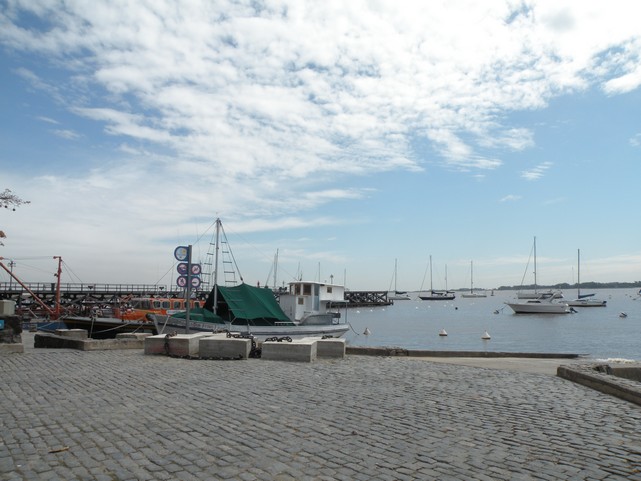

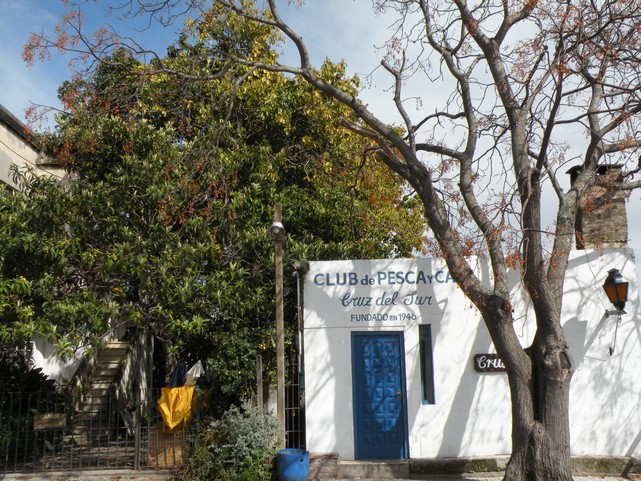

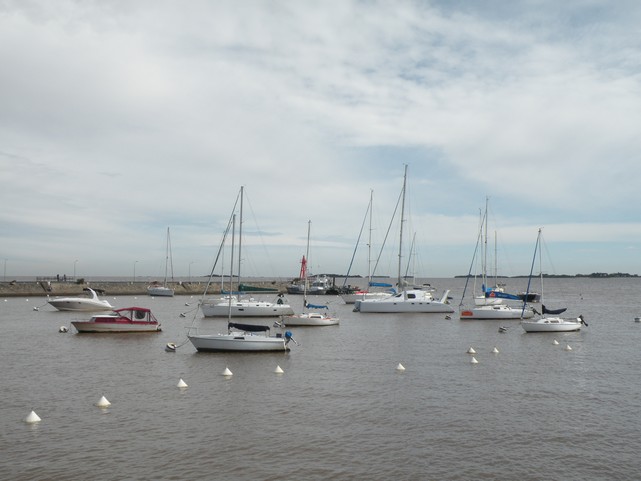

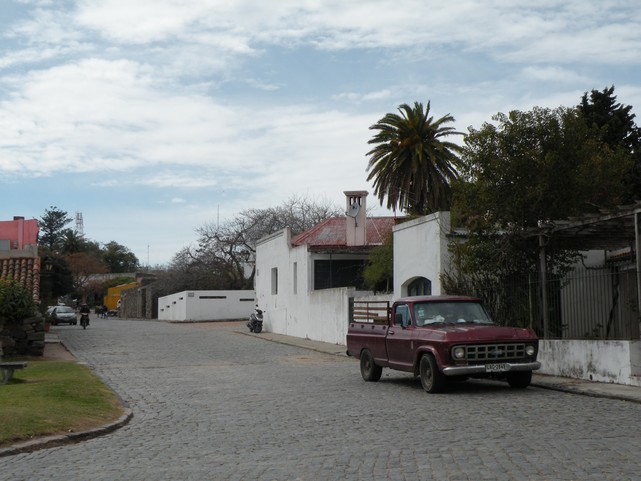



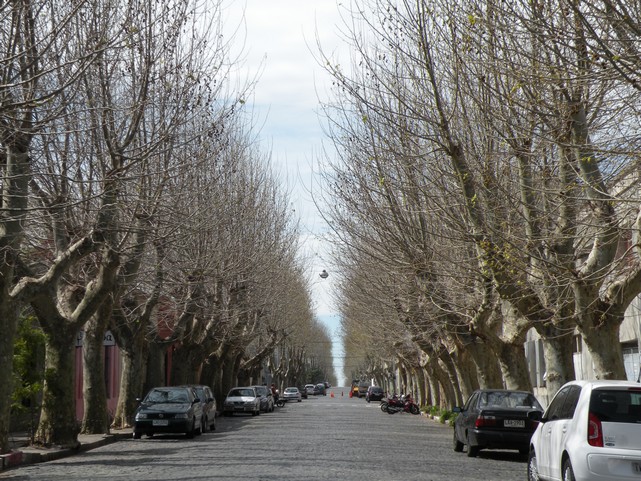

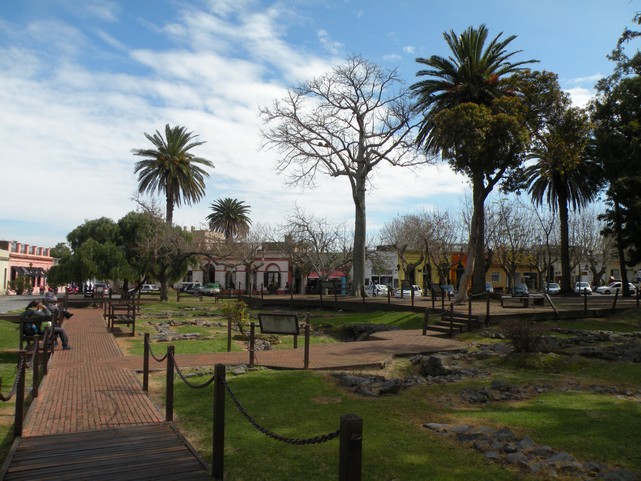

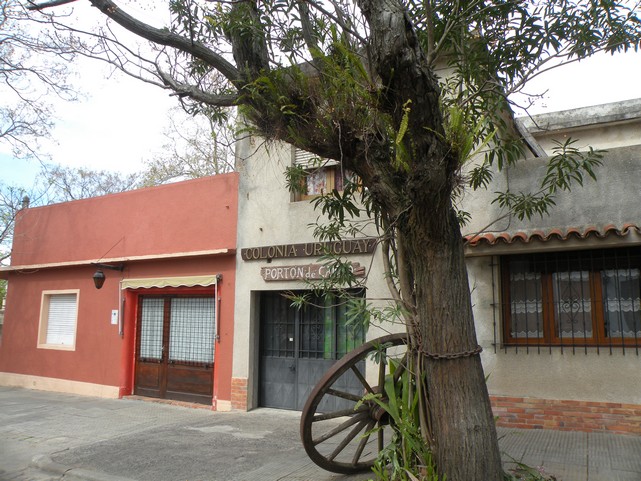

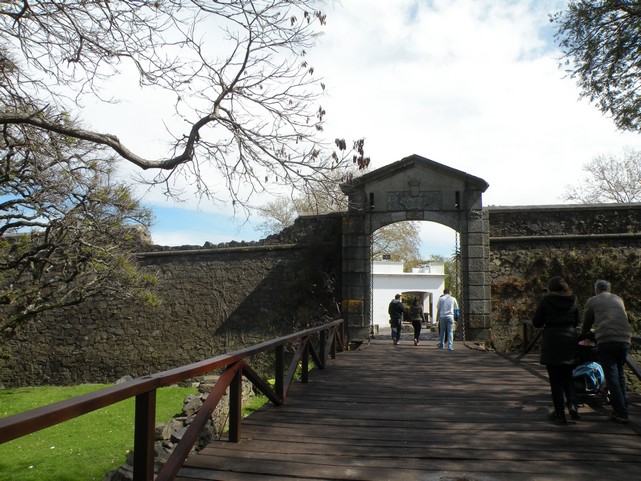







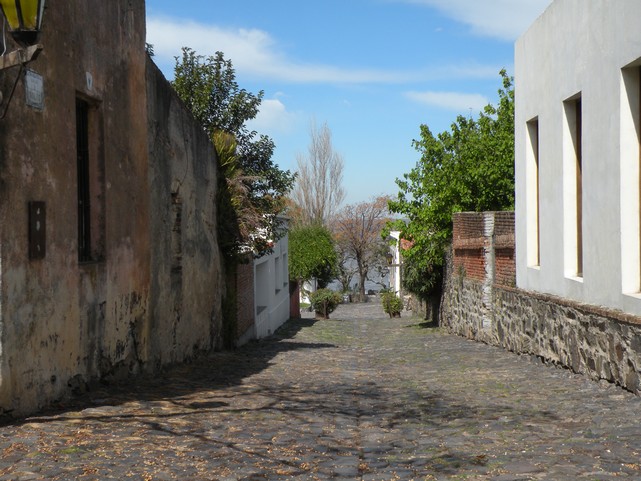







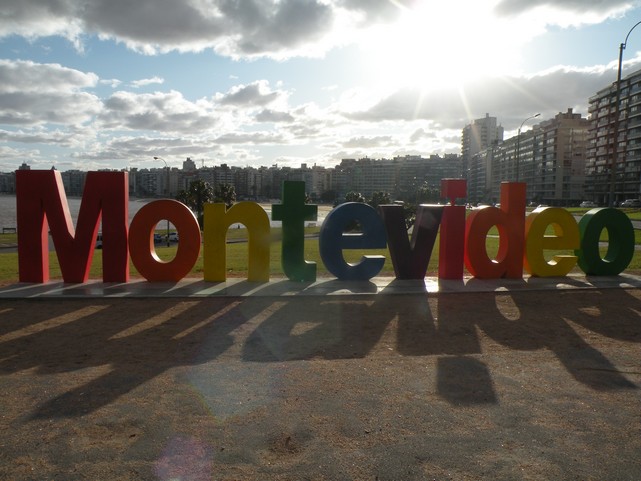

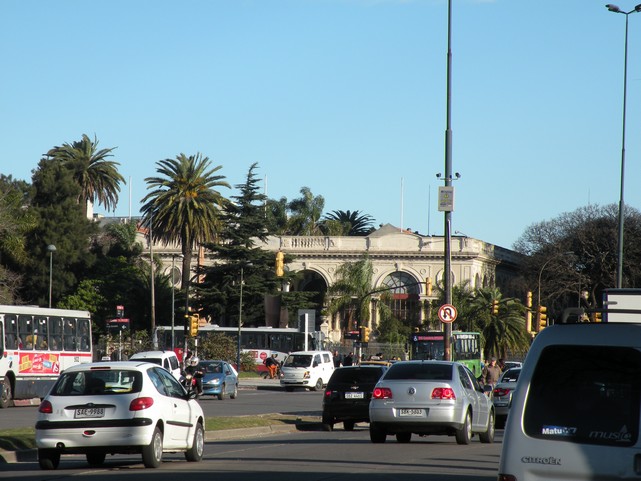

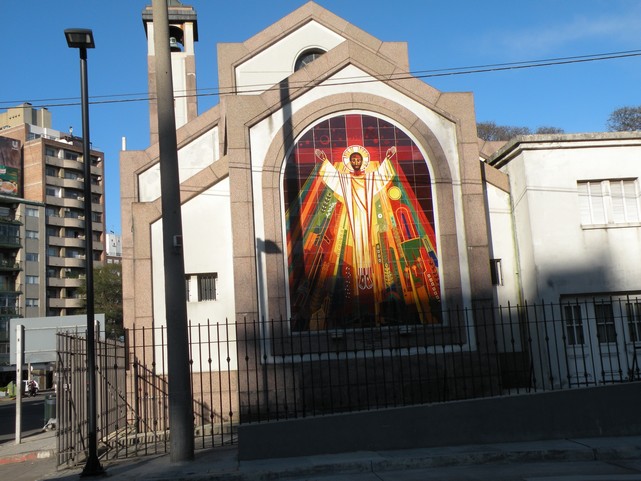

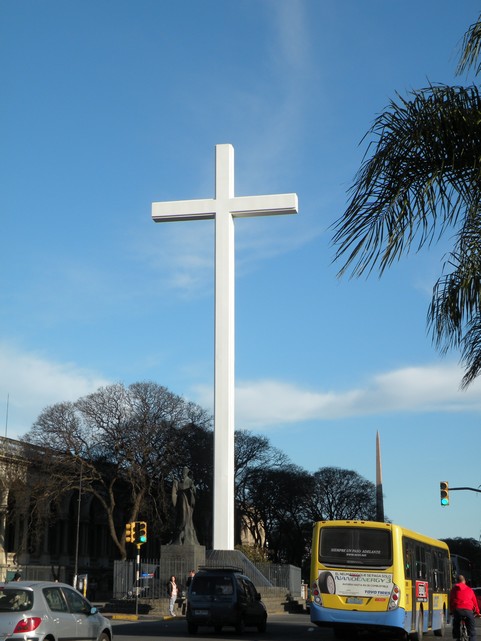



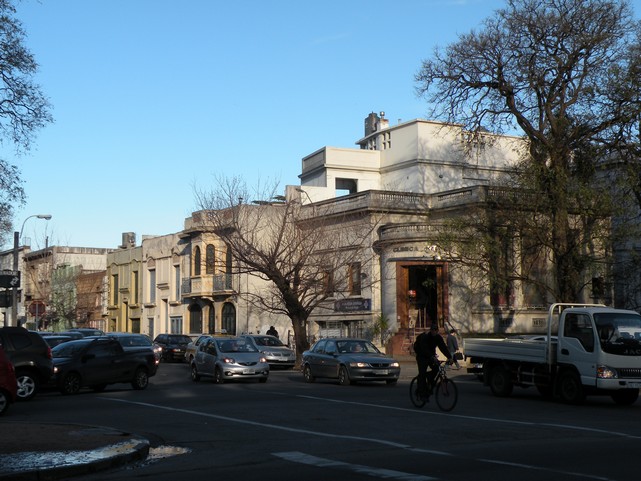

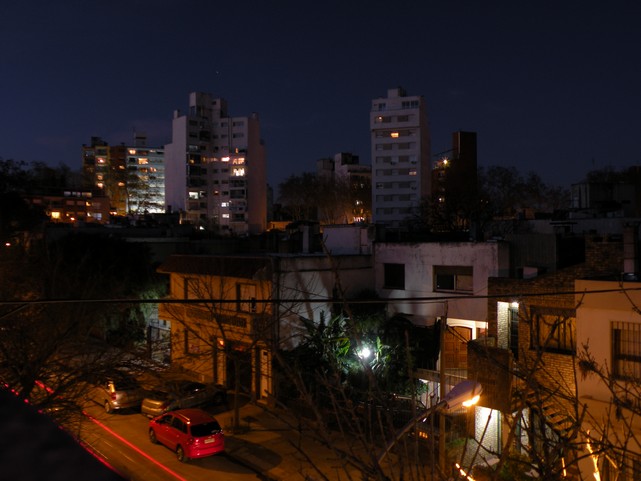

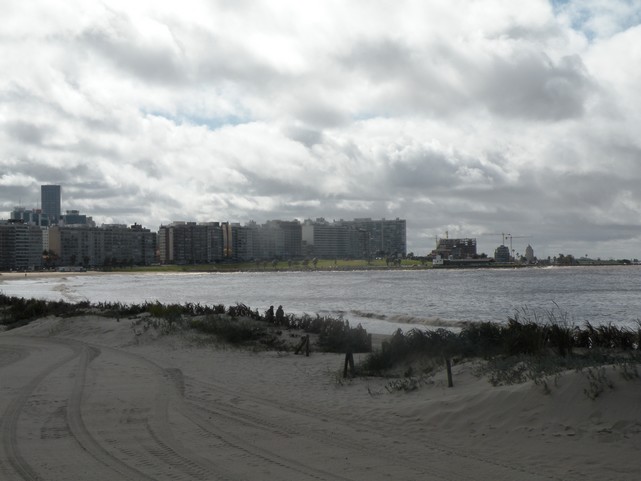

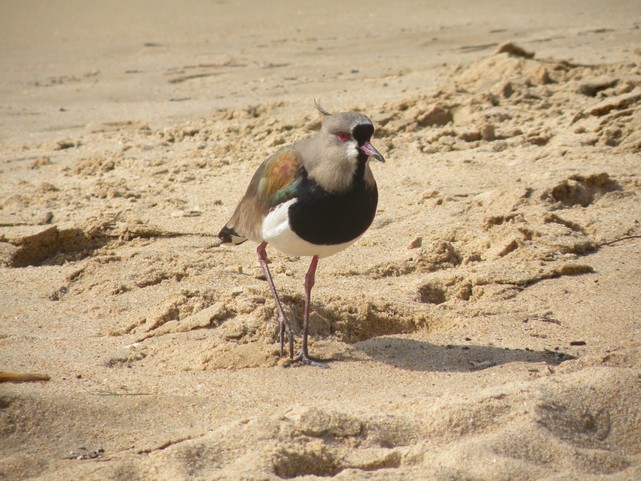

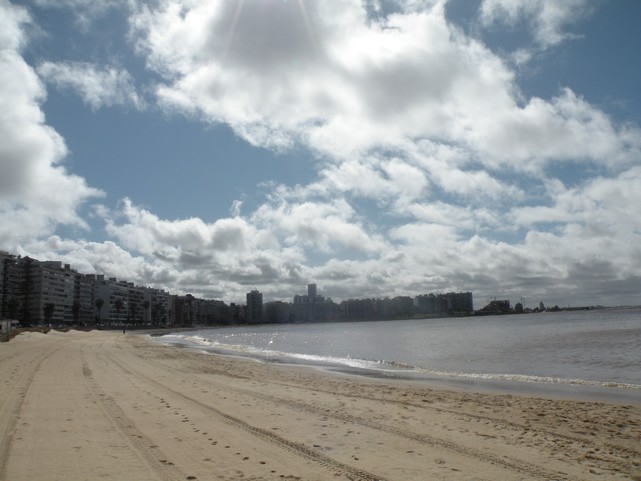

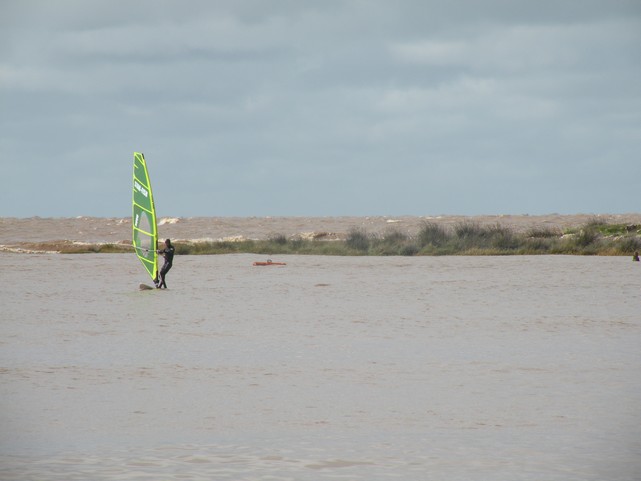



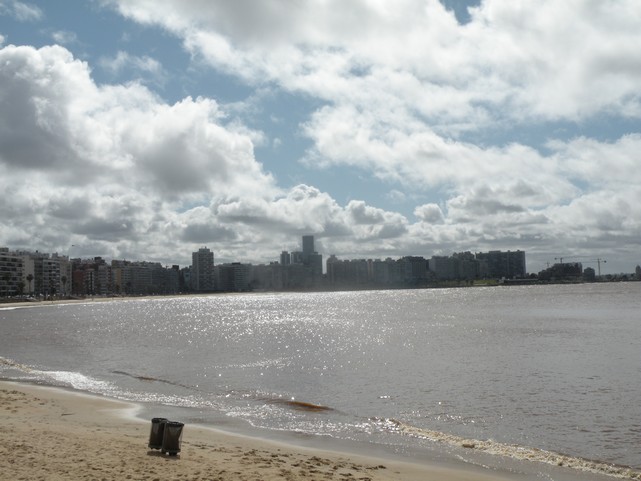

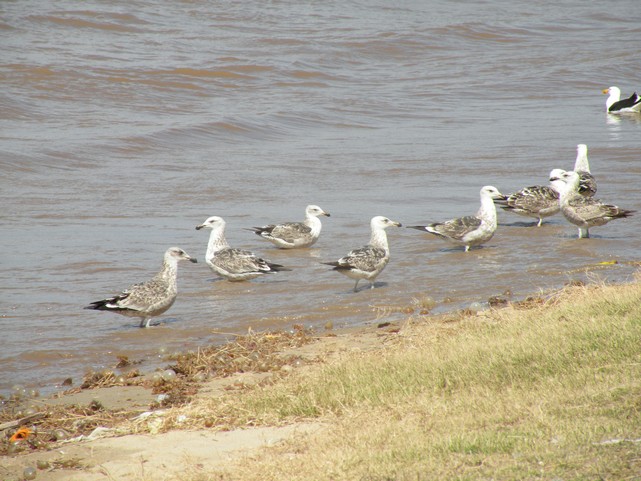

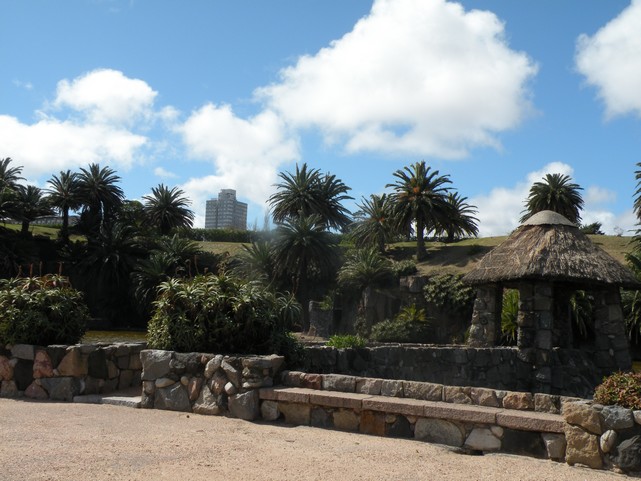



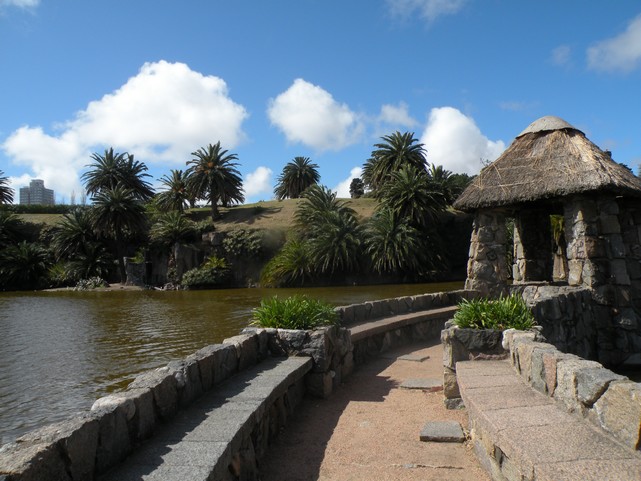

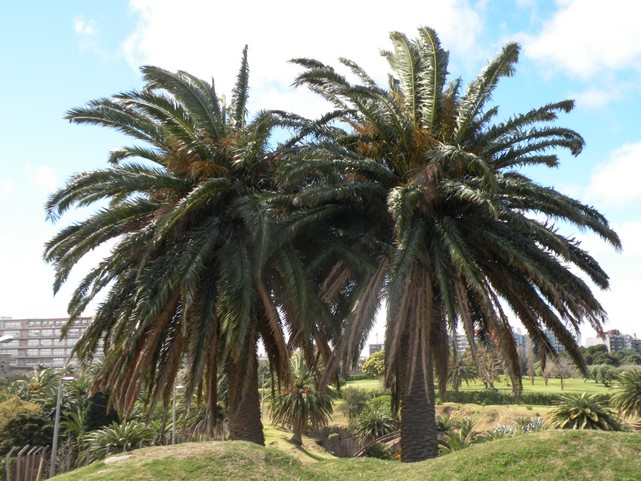

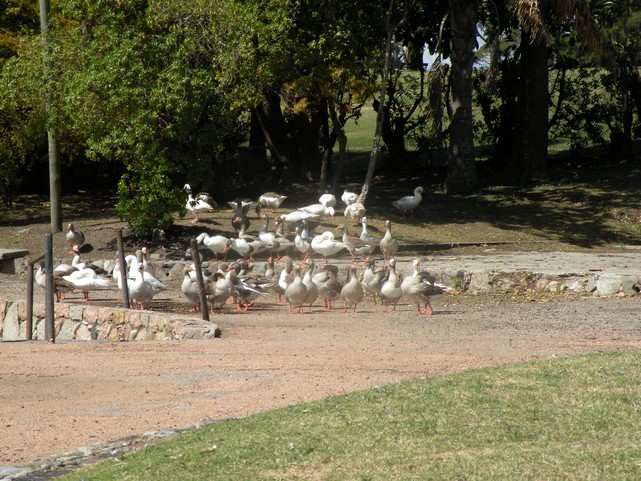

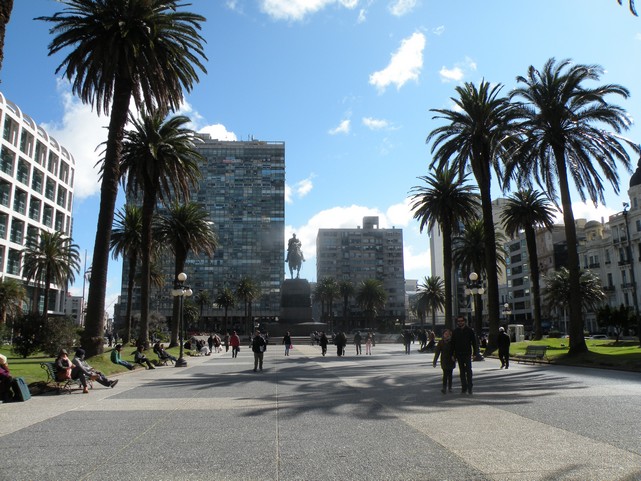

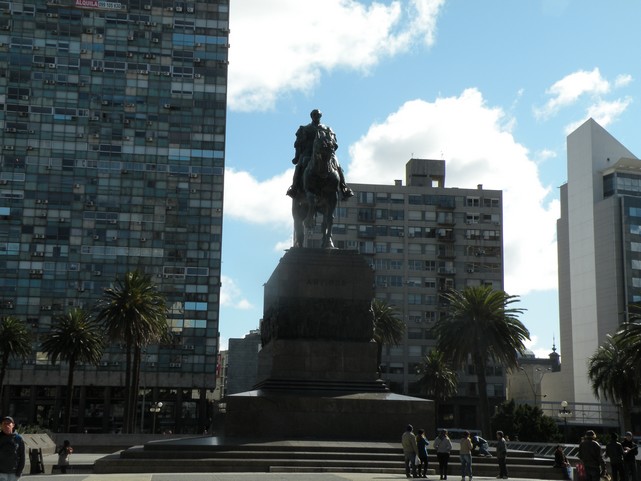

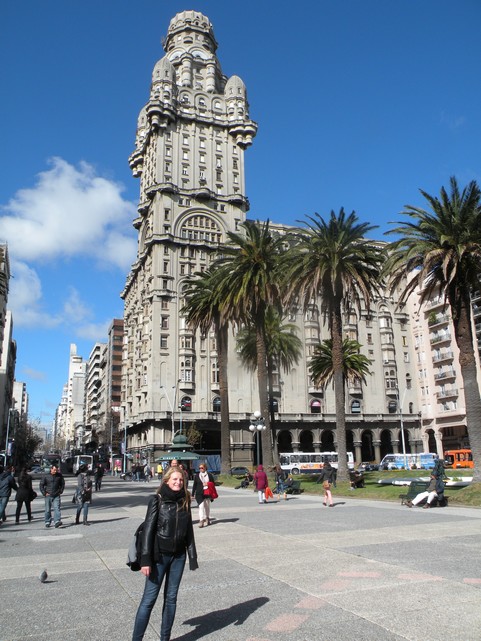

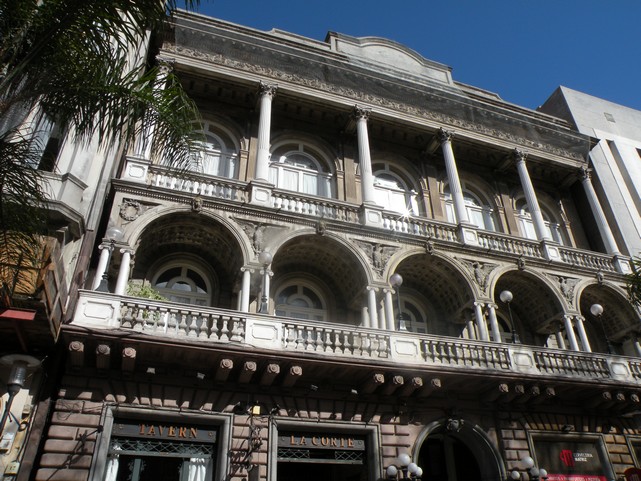





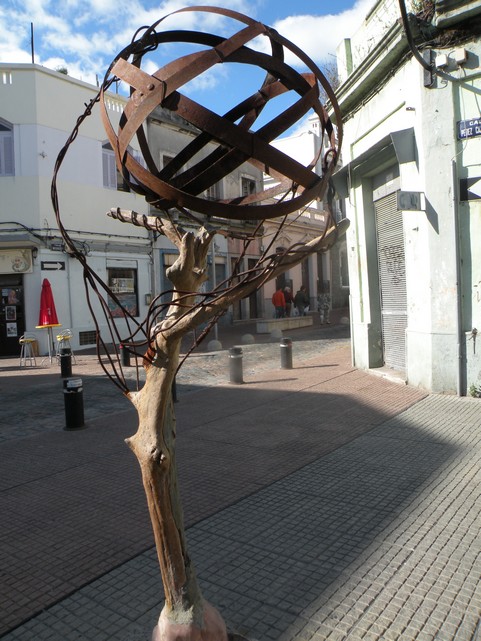

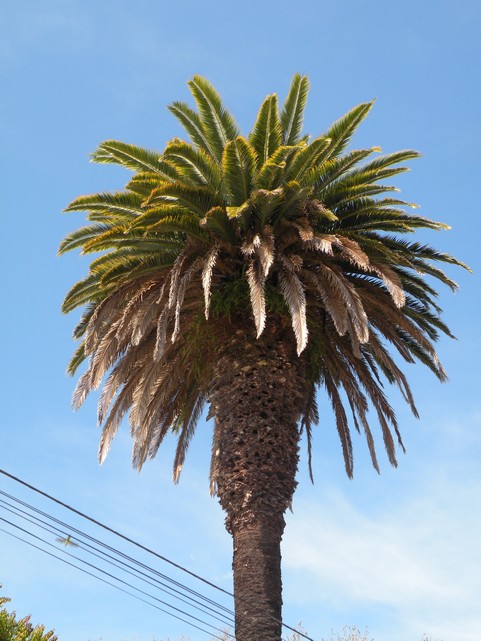

 The next morning I wanted to walk through the capital of Uruguay. I took the way to the beach – Punta del Canario. At the beach are big letters of Montevideo. A taxi driver told me that the city changes the letters and colours. This time, it was very colourful. I walked along the coast in the direction of the centre of the city. It was really windy
The next morning I wanted to walk through the capital of Uruguay. I took the way to the beach – Punta del Canario. At the beach are big letters of Montevideo. A taxi driver told me that the city changes the letters and colours. This time, it was very colourful. I walked along the coast in the direction of the centre of the city. It was really windy  and not so warm. When I walked I discovered a man who walked with dogs, a dog sitter. But not two or maybe three … no, he had 19 dogs at his leads. I heard a lot of dog sitters before. It seems like it is a common mini job in South America. I saw also a lot of dog sitters in Argentina. But this guy with 19 dogs was my record. Incredible – lucky me I made a photo of him because in Germany I am sure everyone would believe I hyperbolize when I tell this story.
and not so warm. When I walked I discovered a man who walked with dogs, a dog sitter. But not two or maybe three … no, he had 19 dogs at his leads. I heard a lot of dog sitters before. It seems like it is a common mini job in South America. I saw also a lot of dog sitters in Argentina. But this guy with 19 dogs was my record. Incredible – lucky me I made a photo of him because in Germany I am sure everyone would believe I hyperbolize when I tell this story.

 I took a taxi back to the hostel to pack my stuff. However, it was already really late and I was almost out of Uruguayan money. It wasn’t enough to pay a second taxi back and I wasn’t sure which bus I had to take. However, I asked the electrician of the hostel to help me. We talked a little bit the last days. So, I asked him to help me to find the right bus. Unfortunately, we had some communication problems because he spoke just a little bit English and my Spanish is really, really bad. In the end, he took a look at my ferry ticket. He talked with a girl from the hostel, then he said I should follow him. I thought he showed me the bus stop because it would be too hard to explain it. But I had forgotton about the hospitable of South Americans. He drove me to the harbour and brought me till the check in. I even wasn’t allowed to give him money for the parking ticket he had to pay to bring me in. He is really so nice and friendly (At this point: ¡Muchas gracias!).
I took a taxi back to the hostel to pack my stuff. However, it was already really late and I was almost out of Uruguayan money. It wasn’t enough to pay a second taxi back and I wasn’t sure which bus I had to take. However, I asked the electrician of the hostel to help me. We talked a little bit the last days. So, I asked him to help me to find the right bus. Unfortunately, we had some communication problems because he spoke just a little bit English and my Spanish is really, really bad. In the end, he took a look at my ferry ticket. He talked with a girl from the hostel, then he said I should follow him. I thought he showed me the bus stop because it would be too hard to explain it. But I had forgotton about the hospitable of South Americans. He drove me to the harbour and brought me till the check in. I even wasn’t allowed to give him money for the parking ticket he had to pay to bring me in. He is really so nice and friendly (At this point: ¡Muchas gracias!).